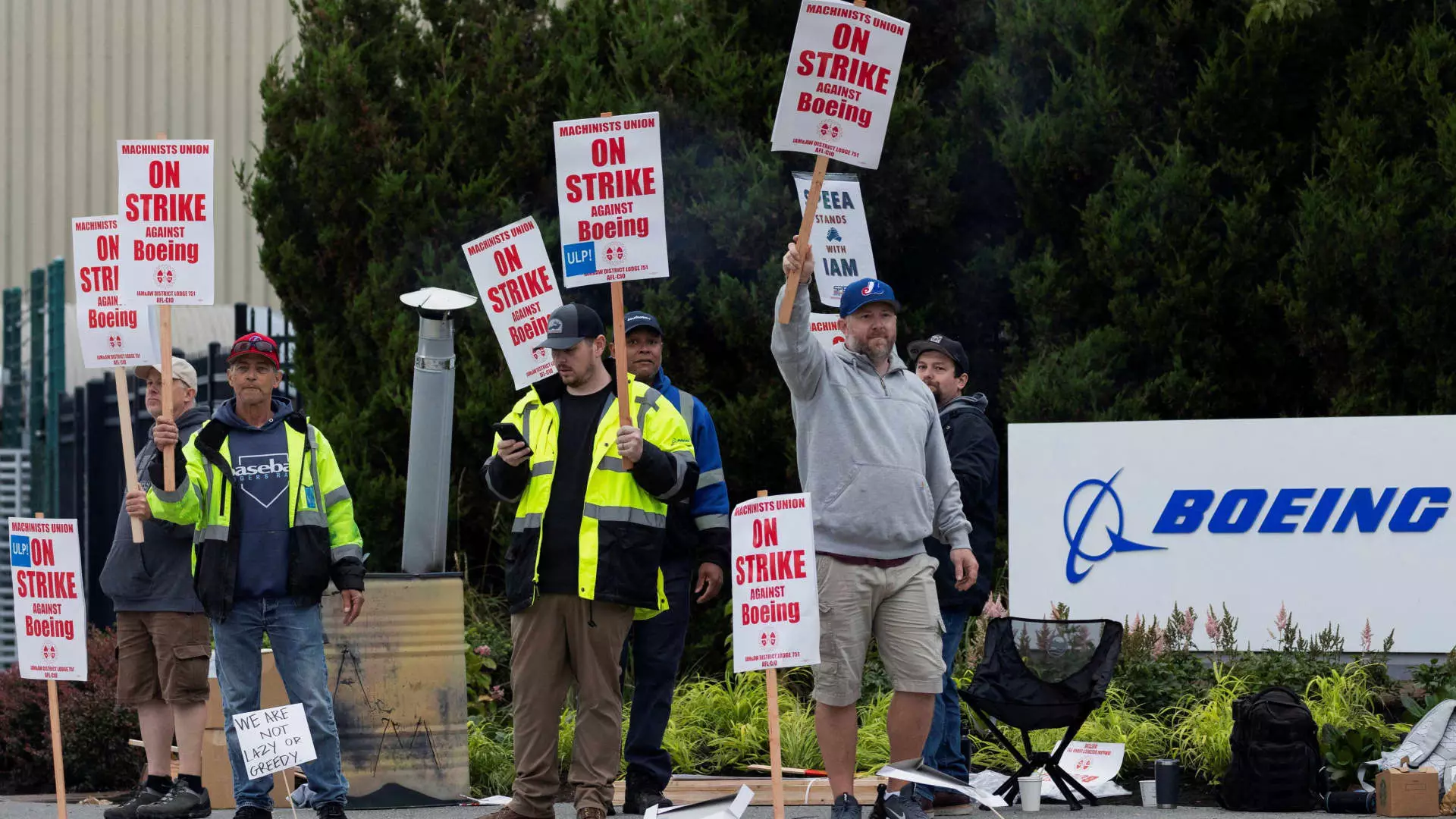In a troubling turn of events for Boeing, the aerospace giant finds itself entangled in a prolonged machinist strike, intensifying the lingering struggles of a company already grappling with substantial financial woes. As workers advocate for improved wages amidst a surging cost of living, the stakes have risen dramatically for both the employees and the organization. The strike, which has now passed its second week, not only represents a pivotal struggle for the machinists in the Pacific Northwest but also threatens to exacerbate Boeing’s precarious situation, where soaring operational costs are compounded by increasing debts and operational interruptions.
Boeing’s financial landscape is painted with precarious strokes; it currently bears a staggering debt burden of $60 billion, coupled with a history of declining profit margins—having not turned a profit since 2018. Following a catastrophic door plug incident earlier this year involving the 737 Max, the company’s losses have escalated further, amounting to approximately $8 billion in 2023 alone. As the stalemate continues, the repercussions of a prolonged strike could lead to financial downgrades from ratings agencies, raising the company’s borrowing costs and possibly stifling its already diminished cash flow.
A Striking Workforce: Resilience Amidst Uncertainty
On the picket lines outside Boeing’s Renton factory, stories of resilience and heartache intertwine as workers prepare for an uncertain future. Many are forced to consider unorthodox side jobs, from landscaping to furniture moving, to bridge the financial gap created by the work stoppage. This scenario not only unearths the everyday struggles of the workers but also highlights the unnerving reality that many families face in a region where the median home price has skyrocketed by 142% in the last decade.
Machinists, who take great pride in their roles within the aerospace manufacturing process, find themselves torn between wanting fair compensation and their love for the craft. Figures like Jake Meyer, a Boeing mechanic, articulate the struggle well: “I take pride in my work,” he reflects, yet he acknowledges his intention to drive for a food delivery service during the strike to make ends meet. This duality—admirable craftsmanship paired with economic hardship—paints a vivid picture of the situation faced by these workers.
As negotiations have unfolded, union members assert their demands for significantly increased wages, pushing for raises closer to 40% rather than Boeing’s latest offer of 25% over four years. The urgency behind these demands is palpable, exacerbated by rising living costs and the impending expiration of health benefits come September 30. The workers’ determination is palpable in their collective efforts to support one another during this tense ordeal, evidenced by union-provided essentials like food and warm shelter during rallying efforts.
The Broader Implications of Corporate Struggles
The landscape of labor relations is becoming increasingly complex, with Boeing’s situation reflecting wider movements across various industries. Workers from sectors as diverse as automotive to entertainment have been consolidating efforts to demand fair compensation and improved work conditions, culminating in hard-fought victories post-strike or strike threats. In this light, the ongoing Boeing strike is emblematic of an evolving labor movement that demands respect and recognition of workers’ contributions at a time when skills in technical fields are becoming increasingly scarce.
Boeing’s leadership finds itself at a pivotal juncture, with CEO Kelly Ortberg — in his nascent tenure — navigating a path littered with obstacles such as planned furloughs and a hiring freeze. He has expressed a commitment to engaging in meaningful negotiations but the pace of progress has left many feeling disillusioned. As the union negotiators shared, “No meaningful progress was made during today’s talks,” further fueling the frustration among workers who had hoped for swift resolutions.
The ramifications of this impasse extend beyond the immediate labor dispute, casting shadows on Boeing’s relationships with its expansive supply chain. The disruption in production has dictated a ripple effect, forcing some suppliers to cease shipments in light of halted aircraft manufacturing. As the company scrambles to readdress its staffing and training challenges, many within the organization are left to ponder: how long can they sustain this dual pressure from both a volatile labor force and the persistent demands of a competitive marketplace?
As the Boeing strike continues, both the company and its machinists face an uncertain future that underscores the tension inherent in modern labor relations. With corporate responsibility increasingly intersecting with workers’ rights, the ongoing situation may well redefine Boeing’s operational strategies and labor practices. The outcome will not only shape the workforce’s future but also serve as a bellwether for broader labor movements across the nation. In a landscape where skilled labor is hard to come by, bouncing back will require more than just negotiations; it will necessitate a profound reevaluation of how companies like Boeing value and invest in their workforce. As tensions mount, the resolution to this strike will likely reverberate throughout industries well beyond the aerospace sector, influencing labor discourse for years to come.


Leave a Reply